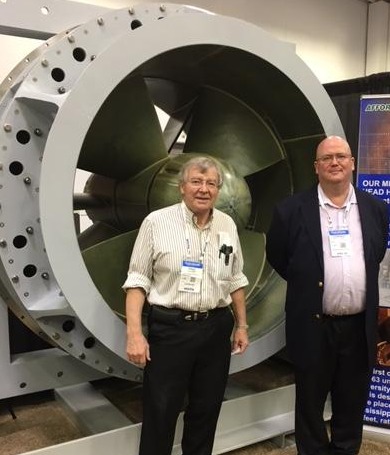Developing Clean Energy Machines
By Bill Kelly
Clean Energy doesn’t exist in the form of electrons ready for powering the grid. But Clean Energy is often available in the form of mechanical energy and its close cousin thermal energy, and we have developed several different machines for our customers looking to transition clean energy into electricity.
There is typically a customized turbomachine at the heart of the energy transformation with a unique set of requirements, often pushing one boundary or another, and nearly always requiring high efficiency. Not only does the fluid or gas flowpath require the highest degree of optimization, but secondary systems such as bearings and seals take on newfound significance. For example, foil bearings can be used on gas systems to reduce friction losses and system complexity, since they rely on the process gas for lubrication, and don’t require a separate oil supply subsystem. Seals that exhibit unacceptable leakage or premature wear are often the Achilles heel of such power generation systems. Maintaining tight running clearances at the seals and/or low friction rubbing surfaces is key to maximizing efficiency.
Renewable Energy
Renewable energy is just that, renewable. However, there is still the issue of making it cost effective, which is where we come in. We have helped develop several highly efficient renewable energy machines to help our customers push the boundaries of economical renewable energy capture. Here are a few...
- Wave Power – Wave power is a tremendous source of renewable energy, but dealing with mechanical motion and salt water is never easy. Enter Wave Swell. This innovative company is using the power of the wave to push air in and out of an enclosure, and capturing the energy from the air flow. Brilliant! Check our Case Study on this effort.
-

Accurate CFD model of Archimedes Screw Turbine

MSI's Dr. Bennett with Amjet founder Paul Roos in front of the ATS-63
Hydro Power – There are many different configurations for capturing energy from falling or moving water. MSI has been involved in the optimal design of approximately 20 turbines covering multiple types. The efforts included advanced computational fluid dynamics, mechanical stress analysis, design, prototyping, and testing. Some examples:
- Pelton Turbine – Ideal for high head low flow. Energy is derived from the impulse of water against buckets. MSI has performed advanced computational fluid dynamics to optimize bucket count and other parameters. Check out our Pelton Turbine example.
- Francis Turbine - The most common hydropower turbine. Radial inward flow enters the runner vanes and exits downward. MSI has been involved with both new designs and rerates, including several projects for Canyon Hydro. Please view our Francis Turbine rerate case study.
- Low Head Turbine – As the name implies these turbine can be installed in rivers or tidal basins where the head differential is low. Construction of these have minimal effects on the environment although they produce less power. MSI has designed and prototyped such a system for Amjet Hydro, a major player in this industry. This case study provides a good overview of our design process on a low head turbine design.
- Archimedes Screw Turbine – Also good for low head, high flow applications, the use of this technology in hydropower is relatively recent. In one instance, MSI has designed the screw and complete flow path geometry, while providing predictions of flow and torque as a function of speed.
Energy Storage
Another form of clean energy we do a lot of work for our customers is with efficient, cost effective forms of energy storage.
- Geomechanical Pumped Storage – Quidnet’s innovative concept uses electrical energy to pump water underground into a body of rock, then recovers this stored energy by releasing the pressurized water back to the surface through a turbine. Funded by DOE, NYSERDA and Bill Gates’ Breakthrough Energy Ventures, among others, this clever system converts electrical energy to geomechanical energy, and then back again.
- Flywheels – MSI principals have previously help develop magnetic bearing suspension systems for different flywheel designs, including both passive and active magnetic bearings. Designs provided up to 50kW over 10 seconds, with speeds of 40-50krpm.
Energy Recovery
Sometimes energy is available in a system and just needs to be efficiently captured. MSI has done several designs of this nature.
- Hydroelectric Generator for Toilets – If you hate changing batteries, you’re not alone. Zurn commissioned us to make a miniature hydroelectric generator to keep their motion sensor batteries continuously charged. Purchase your own Zurn Hydrovantage Hydro Generator Powered Flush Valve here.
- Pressure Reducing Valve Replacement – What do you do if your water supply pressure is too high for what you need? Typically you would install a pressure reducing valve, which simply forfeits the energy available in the pressure reduction. Or, you could use a turbine to reduce the pressure and recapture the energy. That’s what we helped SOAR Hydropower (now a part of Canyon Hydro) do by optimizing an incredibly efficient flowpath for a wide variety of conditions.
Need Help Bringing Your Clean Energy Idea to Life?
We do centrifugal and reciprocating designs, from low speed (about 120 rpm) to high speed (well over 100,000 rpm), with impeller/runner diameters from 1 meter to just over an inch. From flowpath optimization to entire machine development, we love solving the problems associated with pushing the boundaries of clean energy. Let us help you solve yours!
